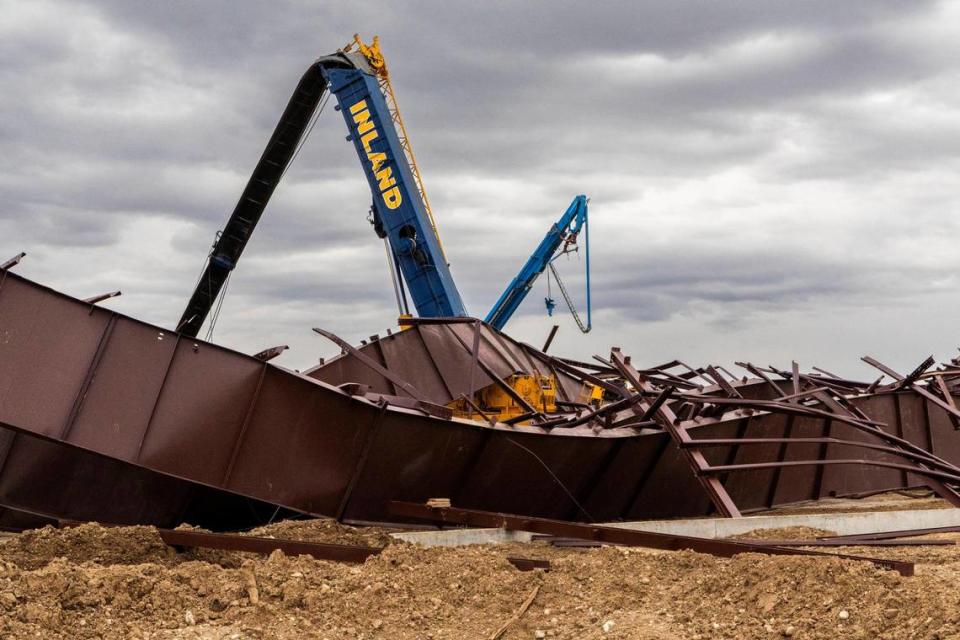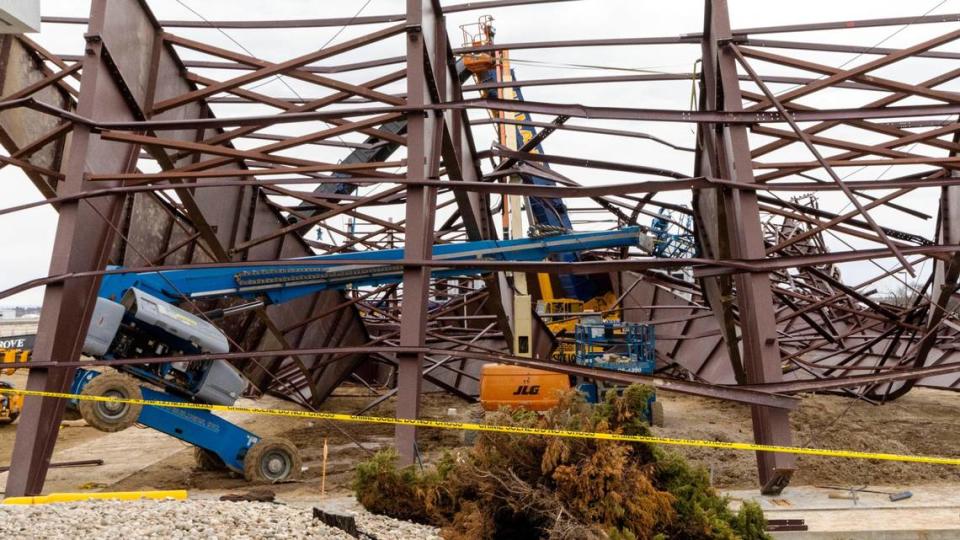What were the cranes doing by the building collapse near Boise Airport? What we know
When a crane and the frame of an unfinished building collapsed near the Boise Airport on Wednesday, killing three and injuring nine, much of the information released was fuzzy at best.
A crane was working on the airplane hangar for Jackson Jet Center. Did it fall on the building? Or did the building collapse on top of it?
Authorities still aren’t saying. But a growing bank of details outline what happened and when.
Perhaps the most significant new information about the crane comes from its operator, Boise-based Inland Crane. Vice President Jeremy Haener said the company was hired to help build the jet hangar and had finished most of the work Wednesday afternoon. Workers moved three of its four cranes off the job site, leaving the last one to place an end truss, which is a part of the roof.
“When the building collapsed due to an unknown structural failure, the crane boom — the hydraulic arm of the equipment — snapped on impact,” Haener said in a news release.
Haener said no evidence pointed toward the crane operators or the crane itself as the reason for the collapse.
None of the Inland Crane employees were injured, he added.
The U.S. Occupational Safety and Health Administration, or OSHA, has taken over the investigation from Boise authorities. That investigation may take months.

What about other factors?
Brian Rigby, president of Local 732 of the Ironworkers Union that covers Montana and Idaho, told the Idaho Statesman that documents showed that there “was definitely enough room in there to safely facilitate four different cranes.”
Rigby, who is based in Montana, said there’s a little more risk with multiple cranes than with one at a work site, but there are other ways the collapse could have started.
Considerations like wind and weather, good concrete, and making sure anchor bolts haven’t been moved or modified are major factors involved in safety, Rigby said.
“In a collapse, there had to be a force that was introduced,” Rigby said.
No members of the union were working at the Jackson Jet Center site, he said.
According to James Headley, CEO of the Florida-based Crane Institute of America, one of the big causes of crane accidents is the ground under the crane giving way, because of loose foundations or soil. For instance, there’s almost always something underground such as wires, communication lines or piping when a crane is setting up on a sidewalk, he said.
“There’s a lot going on when you pick up a load and start moving it,” Headley said by phone. “Cranes are very potentially hazardous even when you’re doing everything right.”
Headley estimated cranes play a role in 20% to 25% of all construction fatalities.
“Mobile cranes are the hardest to operate and require the most skill,” Headley said. “It can be mentally taxing.”

OSHA: Evaluate work when wind gusts reach 20 mph
Guidelines published by OSHA for cranes say that if wind speeds, sustained or in gusts, exceed 20 mph at the personnel platform, then a “qualified person must determine if, in light of the wind conditions, it is not safe to lift personnel.”
If it is not safe, the lifting operation must not start or must stop if already in progress, according to OSHA.
The National Weather Service in Boise recorded a 20 mph gust at the airport about 10 minutes before emergency services were called for the hangar collapse, according to prior Idaho Statesman reporting.
Other safety factors to take into consideration include side-loading, which can happen when a crane operator lifts a load that is not centered, according to Pennsylvania-based crane builder Spanco. This can cause a load to start swinging.
Rigby said the crane at the hangar was a “run of the mill small crane” and nothing like the tower cranes, which dot downtown Boise.
Mobile cranes, like the ones used on the hangar, generally use a telescoping arm and can move around the job site. Static cranes, such as tower cranes Boiseans see when big new buildings go up downtown, are normally built on the job site and stay until construction finishes.
What qualifies a crane operator?
There are a few types of certifications to become a crane operator, with different types offered for certain kinds of cranes or operations.
The standard and most widely accepted certification is through the National Commission for the Certification of Crane Operators, or NCCCO, according to Illinois employment agency Industrial Trade Services.
Requirements for NCCCO certification include being 18 or older, passing a 90-question multiple-choice test in 90 minutes, and operational exams to show proficiency. Candidates must pass the written test and at least one specialty, 26-question exam.
Certifications are valid for five years, and candidates must finish all recertification requirements during the 12 months before the expiration date.
Uncertified workers operating cranes on-site could be faced with a maximum penalty of $16,131 per violation, according to OSHA. More fines could be tacked on for repeated violations.
But certification is nothing more than a “learner’s permit” until a qualified person evaluates the worker, Headley said. It’s not uncommon for someone to skip that last step.
“Training to the test doesn’t help safety,” Headley said.
Historic downtown Boise building condemned by city for ‘dangerous’ structural issues
Save this historic building, a Boisean pleads. We want to, city says. What just happened
The Idaho Sporting Goods store was a Boise icon. It’s now been demolished. This is why
Changes coming to 2 popular blocks in the heart of downtown Boise. Here’s what to know

